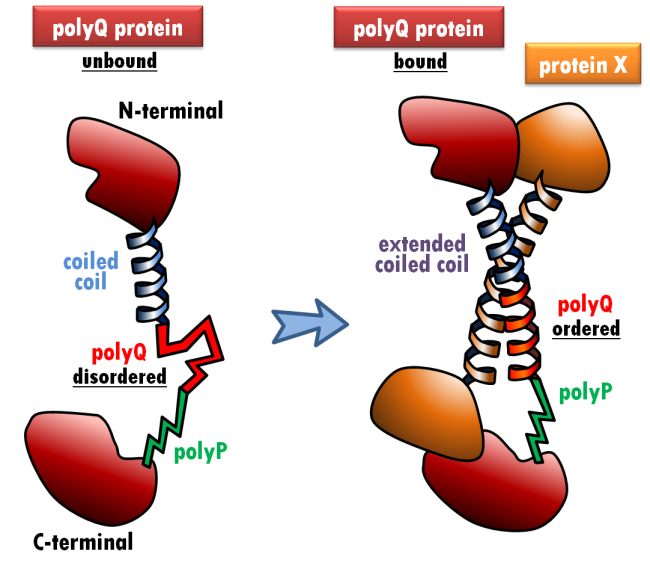Leading computational biologist joins IMB to investigate the role of genes and proteins in disease

©: Miguel Andrade PolyQ modulation of protein-protein interactions. When the polyQ-containing protein (red) interacts with protein X (orange) via a coiled coil interaction, the polyQ adopts a coiled coil conformation, which extends the preceding coiled coil (blue). The polyP region (green) cannot adopt a coiled coil conformation, effectively capping the interaction-dependent conformational change of the polyQ region.
With the vast amount of data generated in modern molecular biology research, powerful methods are needed to understand and make use of the results. For instance, new techniques let researchers model protein interactions, predict how the transcription of genes is regulated, and visualize how genes are expressed, both in health and disease.
Professor Miguel Andrade's work spans all these areas, plus data and text mining of the biomedical literature. These strands of research are connected by the computational tools developed and applied by his group to make sense of large data sets from biological experiments.
One such tool is HIPPIE, a database that integrates protein-protein interaction data. Combining information from genomic, phylogenetic and functional sources, for example, Andrade has shown that stretches of polyglutamine (polyQ) in proteins modulate interactions with other proteins (see Figure).
Abnormal expansion of polyQ can result in pathological protein aggregation, which may contribute to the disease mechanism in various neurodegenerative conditions, such as Huntington’s disease or spinocerebellar ataxia.
One of the main goals of Andrade's work is the prediction of protein and gene function by integrating heterogeneous data. An example of this is his recent observation that microRNA targets and functions can be better predicted using data about the targets of transcriptional suppressor proteins. This finding has been applied to the neural repressor protein REST to identify candidate miRNAs that could act as suppressors of brain cancer.
Another aspect of Andrade's work concerns the development of methods for data and text mining of the biomedical literature, for example abstracts of scientific papers in the PubMed database. Fast prioritization of hundreds of thousands of PubMed records according to user-defined topics in a matter of seconds allows efficient exploration of the biomedical corpus, and can be used to sort genes and chemicals according to their relevance to a topic. Professor Miguel Andrade's group has also used PubMed to study economic, linguistic and scientific trends, and to find appropriate reviewers for manuscripts.
Professor Christof Niehrs, IMB's Founding Director, says the recruitment of Miguel Andrade is a boon for IMB as well as for the wider biology community in Mainz. “Miguel Andrade's computational work ideally complements the wet lab expertise we already have at IMB. As a leader in bioinformatics, Miguel is a pivotal asset for the life sciences in Mainz.”
Professor Miguel Andrade is joining IMB from the Max Delbrück Center for Molecular Medicine in Berlin, where he has headed the Computational Biology and Data Mining group since 2007. From 2003 to 2007, he was Assistant Professor in the Department of Medicine of the University of Ottawa in Canada, and Scientist and Head of the Bioinformatics Group of the Ottawa Health Research Institute. In addition to being appointed professor in the Faculty of Biology at Johannes Gutenberg University Mainz, Professor Miguel Andrade will join IMB as the Institute's 14th Group Leader.
http://www.uni-mainz.de/presse/17172_ENG_HTML.php – press release ;
https://www.imb-mainz.de/research/andrade/research/ – Computational Biology & Data Mining at IMB
Media Contact
All latest news from the category: Life Sciences and Chemistry
Articles and reports from the Life Sciences and chemistry area deal with applied and basic research into modern biology, chemistry and human medicine.
Valuable information can be found on a range of life sciences fields including bacteriology, biochemistry, bionics, bioinformatics, biophysics, biotechnology, genetics, geobotany, human biology, marine biology, microbiology, molecular biology, cellular biology, zoology, bioinorganic chemistry, microchemistry and environmental chemistry.
Newest articles

Security vulnerability in browser interface
… allows computer access via graphics card. Researchers at Graz University of Technology were successful with three different side-channel attacks on graphics cards via the WebGPU browser interface. The attacks…

A closer look at mechanochemistry
Ferdi Schüth and his team at the Max Planck Institut für Kohlenforschung in Mülheim/Germany have been studying the phenomena of mechanochemistry for several years. But what actually happens at the…

Severe Vulnerabilities Discovered in Software to Protect Internet Routing
A research team from the National Research Center for Applied Cybersecurity ATHENE led by Prof. Dr. Haya Schulmann has uncovered 18 vulnerabilities in crucial software components of Resource Public Key…





















